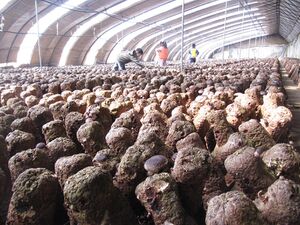
Mushroom growing refers to the growing of mushrooms. In this article, we limit ourselves to the growing of mushrooms suitable for human consumption.
Mushroom species and method of growing[edit | edit source]
Several types of edible mushroom species are available. Unlike what you may assume, all have rather similar environmental needs, namely:
- a very high moisture level
- a temperature of 20° Celcius
- none require light (since there is no photosynthesis) and so can be grown both above ground as well as below ground, and in buildings. Generally, for professional cultivation, they are often grown below ground or in buildings, since temperature and humidity can be better controlled there (enclosed spaces).
However, one major difference for the cultivation is the type of substrate on which the mushrooms best grows; different types of mushroom species grow better on different types of substrate. In general we can distinct between 2 types of substrate:
- wooden logs or sawdust
- manure, compost, straw, or combination of any of these
When using wooden logs, make sure you take wooden logs of about 5-15cm, the logs need to come from recently chopped trees (chopped in winter/resting period), about 5 to 15 cm in diameter. The best results are attained with Betula, Fagus and Quercus. You'll need to drill holes and then introduce brood plugs (inoculated wooden plugs).[1][2]
List of species[edit | edit source]
As mentioned above, typically any type of mushroom can be grown anywhere on the planet using method 2 (not when growing outdoors, ie on logs !), as long as the temperature and humidity is controlled. Still, using native species in your location might have its benefits, as some species might favor a slightly higher/lower temperature, are better able to cope with temperature fluctuations,...
In the tropics, species of Pleurotus are frequently used. In Europe P.ostreatus is best known. In China P.abalonus or P. cystidiosus is generally grown.[verification needed] Other cultivated species include P.sajor-caju, P.florida, P.sapidus, P.eryngii, P. columbinus, P.cornucopiae, and P.abellatus.
Species that should be grown on wooden logs or sawdust:
- Laetiporus sulphureus
- Pleurotus ostreatus
- Hericium erinaceus
- Pholiota nameko
Species that should be grown on manure, compost, straw, or combination of any of these:
- Agaricus campestris
- Macrolepiota procera
- Coprinus comatus
- Lentinus edodes
- Agaricus bisporus
- Lepista nuda
- Stropharia rugoso-annulata
The process[edit | edit source]
Inoculation / Spawning[edit | edit source]
Inoculation refers to the process of introducing either spores or mycelium culture to a spawn substrate. When using manure, compost or straw, it is advisable to sterilise the substrate before inoculation to ensure that no other (inedible) species of mushroom take root. When using wooden logs, sterilization is off course not possible. ZERI at Namibia University is studying ways to do this with firewood and drums.[3]
Incubation[edit | edit source]
Incubation is the time after inoculation and before the mycelium has fully colonized the substrate. Since mushroom has not yet consolidated its hold on the substrate and is, therefor, more susceptible to contamination. It should be noted that the method using logs takes considerable more time to incubate (6 to 12 months), the other method uses but a few weeks.
Fruiting[edit | edit source]
After a substrate is fully colonized it can be fruited. Though the fruit bodies of the mushroom are commonly considered to be mushroom itself, they are only the reproductive organ of the greater organism. In most climates, it is common to build a fruiting chamber in order to provide the correct fruiting conditions for the colonized substrate mycelium to bear fruit bodies. These fruiting conditions often include light, fresh air, proper humidity, and space for mushrooms to grow.
Charisteristics of the different species[edit | edit source]
A project in Ghana working with mushroom farmers from the USA is using Shiitake mushrooms (Lentinus edodes).[4] They claim that these are suitable because:
- Shiitakes are cheaper to grow and require less labor and water than oyster mushrooms.
- Shiitakes are high in protein, 18% (second only to meat by volume), low in fat, contain all the essential amino acids, and have significant health benefits.
- Shiitake mushrooms can improve general health because they strengthen the immune system and contain anti-viral compounds.
- Shiitakes grown on logs are disease resistant and can tolerate drought.
- Shiitakes have the familiar shape of a mushroom.
- They have a shelf life of 2-3 weeks.
- When grown on hardwood logs, rather than on sawdust blocks, they are not susceptible to the types of contamination found on the oyster mushrooms.
Uses of waste mushrooms[edit | edit source]
Any of the mushrooms will have converted the woody waste into a material that can be digested in a biodigester or fed to livestock. Conversion of this type is important to sustainable agriculture. Waste wood, tough crop stalks and rice hulls and other lignified materials are not easy to place back in the natural energy and nutrient cycles. However, by cultivating edible oyster mushrooms, a valuable food is produced. Any that are not wanted or not suitable for human food can feed livestock or produce biogas in biodigesters.
Mushroom compost (sometimes also called 'spent mushroom compost') is a by-product of mushroom cultivation and is often considered to have beneficial properties when added to soil.[5]
References and notes[edit | edit source]
- ↑ Inoculating logs
- ↑ HDRA encylopedia of organic gardening by Pauline Spears
- ↑ ZERI Namibia
- ↑ http://www.mushroomsinghana.org/
- ↑ Mushroom compost page
- http://www.mushroomcompost.org/
- Some of the following information is taken from the Mycology Wiki under their SS-BY-SA license.
See also[edit | edit source]
- Back to the Roots - Organization
- Bioconversion of Organic Residues for Rural Communities/16
- Mycoremediation - Use of fungi to break down or remove toxins from the environment